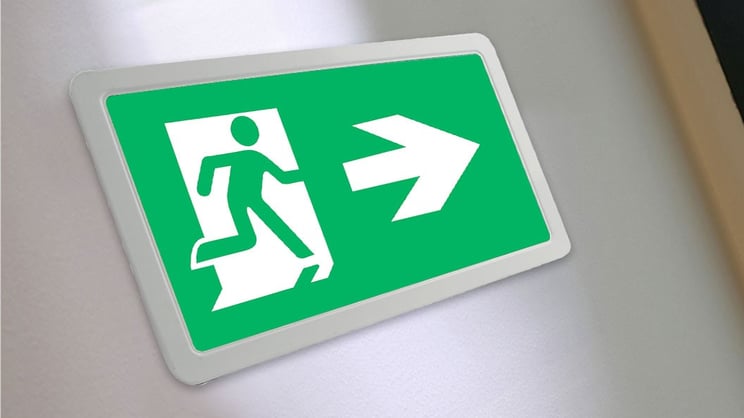Emergency lighting needs to be checked every month. Any repairs or remedial work must be carried out within a reasonable time and all changes must be recorded.
Anecdotal evidence suggests that a significant proportion of organisations do not regularly test and maintain their emergency lighting.
This is partly because standards have changed (BS 5266 was updated in 2016) and the relevant people may be behind the times. But it’s also because testing emergency lighting every month (and annually for a three hour test) is rather laborious and labour intensive, and therefore expensive.
The fines for non-compliance are even more expensive.
Installing the right test mechanism to make compliance easy is fundamental.
How much does compliance cost?
Let’s say you have 50 emergency fittings. How much will it cost to test them manually?
You have to test as follows:
- Monthly functional test: simulate a failure of the normal lighting supply for sufficient time to allow all luminaires to be checked for correct operation, and check for visual signs of damage or deterioration. The standard procedure is to install a test key switch in each room or area as part of the lighting circuit. A small ‘fish tailed’ key is then inserted into the test switch to simulate failure in the mains supply to the circuit.
Cost: 3-4 hours for someone to walk around, test and record in log book. Around £100 per month, 12 months = £1,200 per year.
- Annual tests: simulate failure of the normal lighting supply for the full emergency duration (typically three hours) to ensure emergency lights are able to function for the full duration. The batteries will be discharged as a result of this test such that the emergency lighting system will not function fully until the batteries have had time to discharge. Therefore the test needs to be performed whilst the building is empty or at times of minimal risk, or alternate luminaires need to be tested to ensure there is always cover. The annual test is likely to cost the organisation at least £400.
On top of that there will be maintenance costs, particularly if the lighting is old. Allow another £250 minimum for maintenance.
So the true cost of manually testing and maintaining 50 emergency lights is going to be in the order of £1850 per annum.
How much does it cost to upgrade to some sort of automatic testing?
There are essentially two ways in which to automate testing:
- use self-test emergency luminaires;
- use an ‘automatic test system’ that tests luminaires centrally and ensures full compliance with legislation with minimal hassle.
1) The self-test emergency luminaire
This is the simplest ‘stand-alone’ type of automatic testing. The self-test emergency luminaire checks itself to ensure that the fitting is fully operational, and the result of the automatic test is usually indicated through a single bi-colour LED on luminaires.
Depending on the system, the luminaires typically initiate an emergency functional test every 8-28 days and a duration test every 13 to 26 weeks. They are easy to install and there is no need for the key switch mentioned above.
Note that the responsible person will still need to make monthly visual checks to monitor the fault LEDs, and results of tests still need to be recorded manually into a log book. However, the person recording information does not need to put installations into test and wait to see whether the rated discharge duration is achieved and need not be electrically qualified. Qualified personnel are only needed to rectify faults and re-set systems.
It is important to ensure that adjacent luminaires do not test at the same time, which would leave an area without emergency cover whilst the batteries are recharging. All emergency luminaires that use stand-alone automatic testing need to find a way around this problem, such as delaying the testing of alternate luminaires.
2) Automatic test systems (ATS)
To avoid having to record test results by hand, there are a range of automatic test emergency lighting systems which connect emergency luminaires to a remote control panel where the results are collected centrally, either via data cabling or wireless link.
These systems are easy to retrofit and achieve regulatory compliance with minimal hassle.
Benefits are as follows:
- 24/7 monitoring;
- remote access to view the system and the status of every emergency luminaire within it;
- no hassle self-testing and reporting, ensuring easy compliance;
- test records kept for 4 years;
- fault notifications emailed to the relevant person.
If the fire officer calls and asks to see your test records, they’ll all be there, beautifully organised, without you having to get up from your chair.
The cost of upgrading our 50 luminaire system would be in the order of £10,000: hence just over a 5 year payback. The luminaires all use LED, and have an expected life of around 15 years, and, for maintained luminaires (i.e. emergency lights that are on when the normal mains lighting is on), much lower running costs than the non-LEDs that they are probably replacing. When the 50% saving on running costs are taken into account, the payback time can fall as low as 3 years.
In summary, by installing an Automatic Test System you can achieve three things:
- easy initial compliance with BS5266:2016;
- easy testing, maintenance and ongoing BS5266 compliance;
- lower running costs for maintained emergency lights.
If you would like advice or assistance on upgrading the test mechanism for your emergency lighting, please call us on 0118 951 4490.









